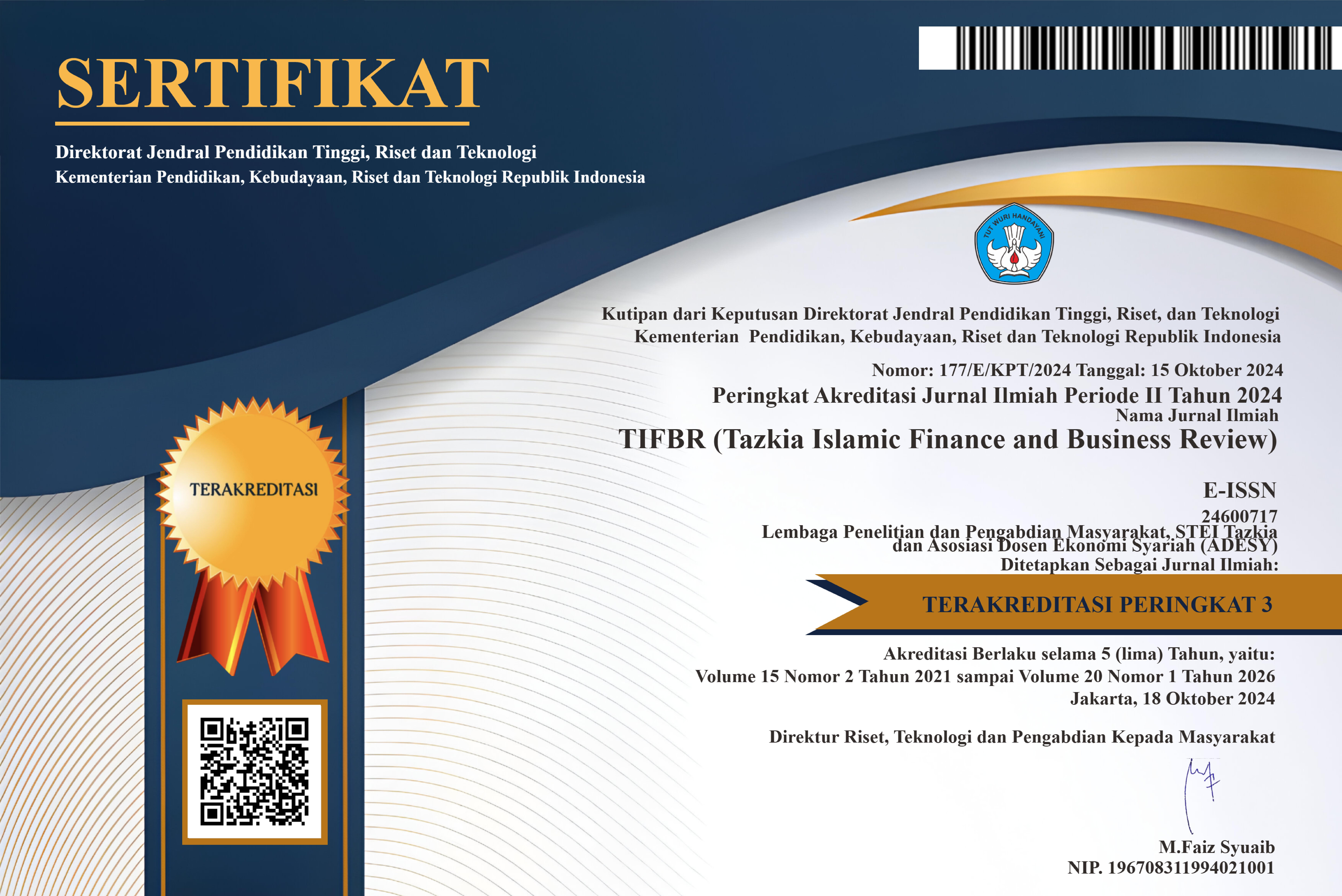Predicting customers’ adoption of Islamic banking services in Tunisia:A Decomposed Theory of Planned Behaviour approach
DOI:
https://doi.org/10.30993/tifbr.v9i1.76Kata Kunci:
Tunisia, Islamic Bank, Decomposed theory of planned behaviourAbstrak
Objective -The main purpose of the study is to examine the willingness of the Tunisian customers to adopt Islamic banking services, and the factors that may influence their decision.
Methods - A total of 100 questionnaires were randomly distributed to Tunisian banking customers, out of which 93 were properly filled and returned. Multiple regression and one sample t-test were subsequently applied.
Results – The results showed that uncertainty, compatibility, awareness as well as subjective norm, have a significant impact on the attitude towards Islamic banking services in Tunisia. Likewise, normative belief was also found to have a significant influence on subjective norm, with particular reference to the parents, siblings, peers and colleagues, as the main referent groups. In addition, self-efficacy was found to have a significant influence on perceived behavioural control, and finally, attitude and subjective norm were found to have a significant impact on the intention to adopt Islamic banking services in Tunisia.
Conclusions -Tunisian customers are willing to shift to Islamic banking services.
Keywords: Tunisia, Islamic Bank, Decomposed theory of planned behaviour
Referensi
Abdullah, R.F.S., & Abdul Rahman, A. (2007). Factors Influencing Knowledge of Islamic Banking Services: The Case of Malaysian Bank Managers. Review of Islamic Economics, 11(2), 31-54.
Ajzen, I. (1991). The theory of planned behavior. Organizational Behaviour and Human Decision Processes, 50, 179-211.
Ajzen, I., &Fishbein, M. (1980). Understanding attitudes and predicting social behaviour. Englewood Cliffs, NJ: Prentice-Hall.
Al-Majali, M., and Nik Mat, N.K. (2010). Application of decomposed theory of planned behaviour on internet banking adoption in Jordan. Journal of Internet Banking and Commerce, 15(2).
Beiginia A. R, Besheli A. S., Suluklu M.E. and Ahmadi M. (2011). Mobile Banking Adoption based on the Decomposed Theory of Planned Behaviour. European Journal Economics Finance and Administration Sciences, 1450-2275.
Caperchione, C., Duncan, M., Mummery, K., Steele, R. & Schofield, G. (2008). An examination of the mediating relationship between body mass index and the direct measures of the theory of planned behaviour on physical activity intention. Psychology, Health and Medicine,13(2), 168-179.
Chin, W.W. (1998). Issues and opinion on structural equation modelling. MIS Quarterly, 22(1), 7-16.
Davies, F.D. (1989). Perceived Usefulness, Perceived Ease of Use, and User Acceptance of Information Technology. MIS Quarterly, 13(3), 319-340.
Dusuki, A.W., and Abdullah, N.I. (2007). Why do Malaysian Customers Patronise Islamic Banks? International Journal of Bank Marketing, 25(3), 142-160
Echchabi, A., &Echchabi, F. (2013). Islamic insurance in the European countries: Insights from French Muslims perspective. WSEAS Transactions on Business and Economics, 10(3), 125-132.
Edris, T. (1997). Services considered important to business customers and determinants of bankselection in Kuwait: A segmentation analysis. International Journal of Bank Marketing,15(4), 126-34.
Erol, C. and El-Bdour, R. (1989).Attitudes, behaviour and patronage factors of bank customers towards Islamic banks. International Journal of Bank Marketing,7(6), 31-37.
Erol, C., Kaynak, E., & El-Bdour, R. (1990). Conventional and Islamic banks: Patronage behaviour of Jordanian customers. International Journal of Bank Marketing, 8(4), 25-35.
Fisher, R., & Chu, S.Z. (2009). Initial online trust formation: The role of company location and web assurance. Managerial Auditing Journal, 24(6), 542-563.
Gerrard, P., & Cunningham, J. (1997). Islamic banking: A study in Singapore. InternationalJournal of Bank Marketing, 15(6), 204-16.
Gliem, J.A., and Gliem, R.R. (2003). Calculating, interpreting and reporting Cronbach’s Alpha reliability coefficient for likert-type scales. Midwest Research to Practice Conference in Adult, Continuing and Community Education. Ohio: Ohio State University.
Hair, J.F., Black, W.C., Babin, B.J. and Anderson, R.E. (2010). Multivariate data analysis, seventh edition. Prentice Hall, Upper saddle river. N. J.
Haron, S., Ahmad, N. and Planisek, S. (1994). Bank patronage factors of Muslim and non-Muslim customers. International Journal of Bank Marketing, 12(1), 32-40.
Hegazy, I.A. (1995). An Empirical Comparative Study between Islamic and Commercial Banks’ Selection Criteria in Egypt. International Journal ofContemporary Management, 5(3), 46-61.
Iqbal, Z. (1997). Islamic Financial Systems. Finance and Development.
Iqbal, M., Khan, T., & Ahmed, A. (1998). Challenges facing Islamic banking. Occasional paper 2, Jeddah: IRTI/IDB.
Lin, Y.M. (2005). Understanding students’ technology appropriation and learning perceptions in online learning environments. Unpublished PhD thesis. United States: University of Missouri-Columbia.
Lee, J., Cerreto, F. A., & Lee, J. (2010). Theory of Planned Behavior and Teachers' Decisions Regarding Use of Educational Technology. EducationalTechnology& Society, 13(1), 152–164.
Martens, A. (2001). La Finance Islamique: Fondements, Théorie et Réalités. Centre de recherche et développement en économique, cahier 20-2001, Université de Montréal.
Metwally, M. (1996). Attitudes of Muslims towards Islamic banks in a dual-banking system. American Journal of Islamic Finance, 6, 11-17.
Meyers, L.S., Gamst, G., &Guarino, A. (2006). Applied multivariate research: Design and interpretation. Thousand Oaks, CA: Sage Publishers.
Naser, K., Jamal, A. and Al-Khatib, K. (1999). Islamic banking: a study of customer satisfaction and preference in Jordan. International Journal of Bank Marketing, 17(3), 135-50.
Ndubisi, N.O. (2004). Factors influencing e-learning adoption intention: Examining the determinant structure of the decomposed theory of planned behaviour constructs. Paper presented at the HERDSA Conference. Miri, Sarawak, 4-7 July. Retrieved from http://www.herdsa.org.au/conference2004/Contributions/RPap ers/P057-jt.pdf.
Nor, K.M. (2005). An empirical study of internet banking acceptance in Malaysia: An extended decomposed theory of planned behaviour. Unpublished PhD thesis, Southern Illinois: University Carbondale.
Okumus, S.H. (2005). Interest free banking in Turkey: a study of customer satisfaction and bank selection criteria. Journal of Economic Cooperation, 26(4), 51-86.
Püschel, J., Mazzon, J.A., and Hernandez, J.M.C., (2010). Mobile banking: proposition of an integrated adoption intention framework. International Journal of Bank Marketing, 28(5), 389-409.
Rammal, H.G. and Zurbruegg, R. (2007). Awareness Of Islamic Banking Products Among Muslims: The Case Of Australia. Journal of Financial Services Marketing, 12(1), 65-74.
Rogers, E. (1983). Diffusion of Innovations. New York: The Free Press.
Sharma, S and Bock, G. (2005). Factors Influencing Individual's Knowledge Seeking Behaviour in Electronic Knowledge Repository. ECIS 2005 Proceedings. Paper 49. Retrieved athttp://aisel.aisnet.org/ecis2005/49.
Shih, Y., & Fang, K. (2004). The use of a decomposed theory of planned behaviour to study Internet banking in Taiwan. Internet Research, 14(3), 213-223.
Rehlander, T., &Csonka, A. (2009). Islamic Finance Comes of Age. Arthur D. Little, April.Retrieved at www.adl.com
AFDB (2011). Islamic Banking and Finance in North Africa. African Development Bank, Tunisia.
Ayari, S. (2011). Ennahdha Promotes an Islamic Financial System. Tunisialive, November. Retrieved at http://www.tunisia-live.net/2011/11/10/ennahdato-reform-the-banking-system-and-to-give-tunisia-a-regional-active-role/
El Oudi, O. (2011a). Tunisia Aspires To Become A Hub For Islamic Finance. Business Life, August. Retrieved at http://www.cibafi.org/Images/Attaches/201181825226431.pdf
El Oudi, O. (2011b). Tunisie: La finance islamique pour relancer l'économie!!.WMC Finance, December. Retrieved at http://finance.webmanagercenter.com/article-113782-tunisie-la-finance-islamique-pour-relancer-l-economie
Leaders (2012). Tunisie: Loi de Finances 2012. Commentaire de la loi de finances 2012. Leaders, January. Retrieved at http://www.leaders.com.tn/article/commentaire-de-la-loi-de-finances-2012?id=7473
Stevens, J. (2002). Applied Multivariate Statistics for the Social Sciences. New York:Routledge.
Suki, N.M. (2010). An empirical study of factors affecting the internet banking adoption among Malaysian consumers. Journal of Internet Banking and Commerce, 15(2), 1-11.
Tan, M., &Teo, T.S.H. (2000). Factors Influencing the Adoption of Internet Banking.Journal of the Association for Information Systems, 1(5), 1-44.
Tavakol, M., and Dennick, R. (2011). Making sense of Cronbach’s Alpha. International Journal of Medical Education, 2, 53-55.
Taylor, S., & Todd, P. (1995a). Understanding information technology usage: A test of competing models. Information Systems Research, 6(2), 144-176.
Taylor, S., & Todd, P. (1995b). Decomposition and crossover effects in the theory of planned behaviour: A study of consumer adoption intentions. International Journal of Research in Marketing, 12,137-155.
Teo, T. S. H., and Pok, S. H. (2003). Adoption of WAP-enabled mobile phones among Internet users. Omega - The International Journal of Management Science, 31(6), 483-498.
Thambiah, S., Eze, U.C., Tan, K.S., Nathan, R.J., & Lai, K.P. (2010). Conceptual framework for the adoption of Islamic retail banking services in Malaysia. Journal of Electronic Banking Systems, Volume 2010, Article ID 750059, available online at http://www.ibimapublishing.com/journals/JEBS/2010/750059/a750059.html.
To, P.L., Liao, C., Chiang, C.J., Shih, M.L., & Chang, C.Y. (2008). An empirical investigation of the factors affecting the adoption of instant messaging in organisations. Computer Standards & Interfaces, 30, 148-156.
Vehkalahti, K. (2000). Reliability of measurement scales. Helsinki:The Finnish Statistical Society.
Visser, H. (2009). Islamic finance principles and practice. UK: Edward Elgar Publishing Limited.
Williams, P.W. (2009). Assessing mobile learning effectiveness and acceptance, Unpublished PhD thesis. Washington: George Washington University.
Zaher, T.S., & Hassan, M.K. (2001). A comparative literature survey of Islamic finance and banking. Financial Markets, Institutions and Instruments, 10(4), 155-199.
##submission.downloads##
Diterbitkan
Cara Mengutip
Terbitan
Bagian
Lisensi

Tazkia Islamic Finance and Business Review (TIFBR) is licensed under a Creative Commons Attribution-NonCommercial 4.0 International License.
Authors who publish with this journal agree to the following terms:
- Authors retain copyright and grant the journal right of first publication with the work simultaneously licensed under a Creative Commons Attribution License that allows others to share the work with an acknowledgment of the work's authorship and initial publication in this journal.
- Authors are able to enter into separate, additional contractual arrangements for the non-exclusive distribution of the journal's published version of the work (e.g., post it to an institutional repository or publish it in a book), with an acknowledgment of its initial publication in this journal.
- Authors are permitted and encouraged to post their work online (e.g., in institutional repositories or on their website), as it can lead to productive exchanges, as well as earlier and greater citation of published work (See the Effect of Open Access).

















